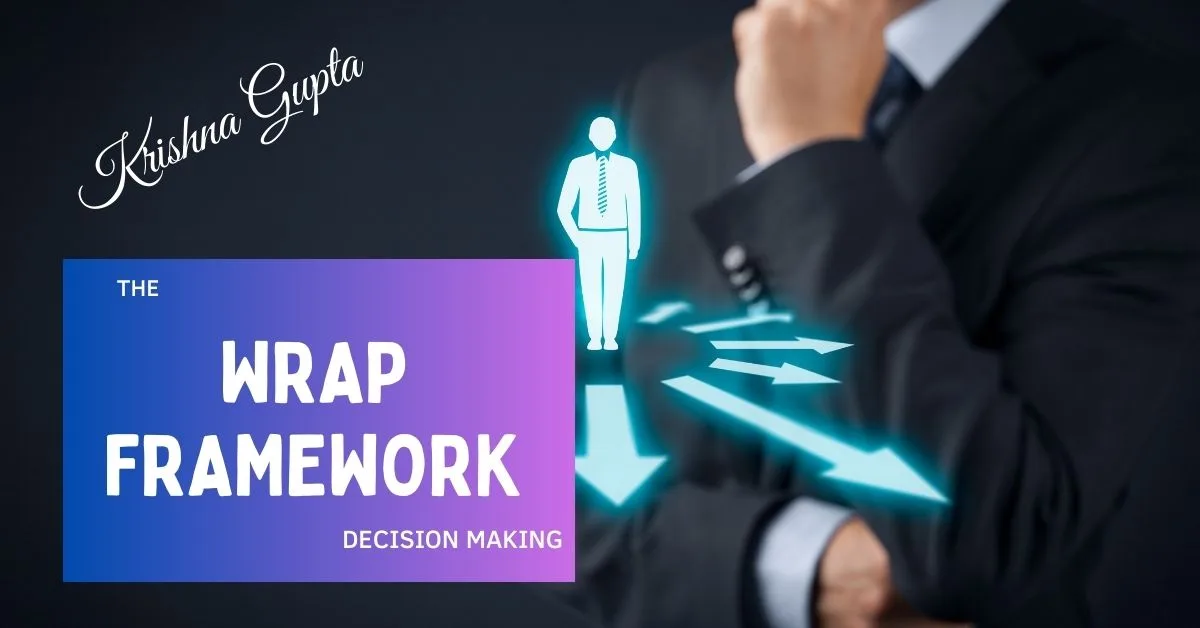Unwrap Better Decisions: The WRAP Framework for Indian MSMEs
Are you feeling overwhelmed by tough choices? Are you struggling to navigate the ever-changing Indian market? If you’re an MSME owner, you’re not alone. Every decision, from product launches to employee expansion, carries weight. But fear not, for a powerful tool called the WRAP framework can help you unwrap better decisions, leading to a more substantial, resilient business.
Here’s a breakdown of the WRAP framework for decision-making:
WRAP stands for:
- Widen Your Options:
- Challenge narrow framing: Avoid limiting yourself to binary choices or default options.
- Consider opportunity costs: Consider what you might miss out on by choosing one path over another.
- Use vanishing options: Recognise that procrastination can lead to options disappearing.
- Multitrack: Explore multiple courses of action simultaneously when possible.
- Find someone who’s solved your problem: Learn from others who have faced similar decisions.
- Reality-Test Your Assumptions:
- Consider the opposite: Actively challenge your initial beliefs and biases.
- Ask for specific information: Seek concrete data to support or refute your assumptions.
- Assume positive intent: Interpret actions generously to avoid unnecessary conflict.
- Consider the “outside” view: Get perspectives from people who aren’t directly involved.
- Ooch: Conduct small experiments or gather incremental evidence to test assumptions.
- Attain Distance Before Deciding:
- Shift perspective: Imagine what advice you’d give to a friend or what your successor would do.
- Use the 10/10/10 technique: Consider the impact of a decision in the short-term, medium-term, and long-term.
- Clarify core priorities: Identify your most important values and goals to guide your choices.
- Prepare to Be Wrong:
- Conduct a pre-mortem: Anticipate potential problems and create contingency plans.
- Plan for adversity and success: Consider handling positive and negative outcomes.
- Set tripwires: Establish signals that prompt you to reevaluate your decision if certain conditions arise.
Key benefits of using the WRAP framework:
- Counteracts common decision-making biases.
- Encourages thorough exploration of options.
- It helps to make more informed and confident decisions.
- Prepare for potential challenges and setbacks.
- Increases adaptability and resilience in the face of uncertainty.
Who is WRAP for?
- MSMEs facing critical decisions: Hiring a new team? Entering a new market? WRAP helps you explore all angles before committing.
- Leaders seeking clarity and confidence: Feeling uncertain? WRAP provides a structured approach to analysing options and overcoming indecision.
- Anyone who wants to make smarter choices: From marketing campaigns to personal investments, WRAP is a versatile framework applicable to any domain.
Who is WRAP not for?
- It is not for those seeking instant gratification: WRAP takes time and effort to implement. If you need a quick fix, look elsewhere.
- Micromanagers: WRAP encourages delegation and seeking diverse perspectives. If you control everything, WRAP might feel uncomfortable.
- Intuition purists: WRAP values data and analysis. If you solely rely on gut feelings, WRAP may seem counterintuitive.
Advantages of the WRAP framework:
- Combats cognitive biases: Our brains have shortcuts that lead to bad decisions. WRAP helps identify and avoid these pitfalls.
- Promotes thorough exploration: It encourages considering all options, not just the obvious ones, leading to more creative and sustainable solutions.
- Boosts confidence: You’ll feel more assured and prepared to handle challenges by making informed decisions.
- Adaptability in uncertain times: The Indian market is dynamic. WRAP equips you to make data-driven decisions even in volatile situations.
Disadvantages of the WRAP framework:
- Time commitment: Implementing WRAP takes time and effort, especially for complex decisions.
- Potential for analysis paralysis: Overthinking can lead to delays. Set time limits to avoid getting stuck in the analysis phase.
- Requires open-mindedness: Challenging assumptions and seeking diverse perspectives can be uncomfortable.
How to use the WRAP framework:
- Widen Your Options: Explore all possibilities, even seemingly outlandish ones. Consider opportunity costs and multitrack if possible.
- Reality-Test Your Assumptions: Don’t fall for confirmation bias. Seek opposing viewpoints and gather concrete data to validate your beliefs.
- Attain Distance Before Deciding: Sleep on it! Get outside perspectives and consider the long-term implications of your decision.
- Prepare to Be Wrong: Conduct a pre-mortem, anticipate challenges, and set tripwires to monitor for signs of failure.
Benefits for Indian MSMEs:
- Improved decision-making: Navigate the competitive Indian market with confidence.
- Reduced risk of costly mistakes: Avoid hasty decisions that can impact your bottom line.
- Increased adaptability: Respond swiftly to changing market trends and regulations.
- Enhanced innovation: Foster a culture of open-mindedness and explore new opportunities.
Remember, WRAP is not a magic formula but a tool to guide and empower your decision-making process. Embrace its principles, adapt it to your unique context, and watch your MSME flourish in the face of any challenge.
So, are you ready to unwrap better decisions with WRAP? Start today and make your MSME a champion of the Indian market!
